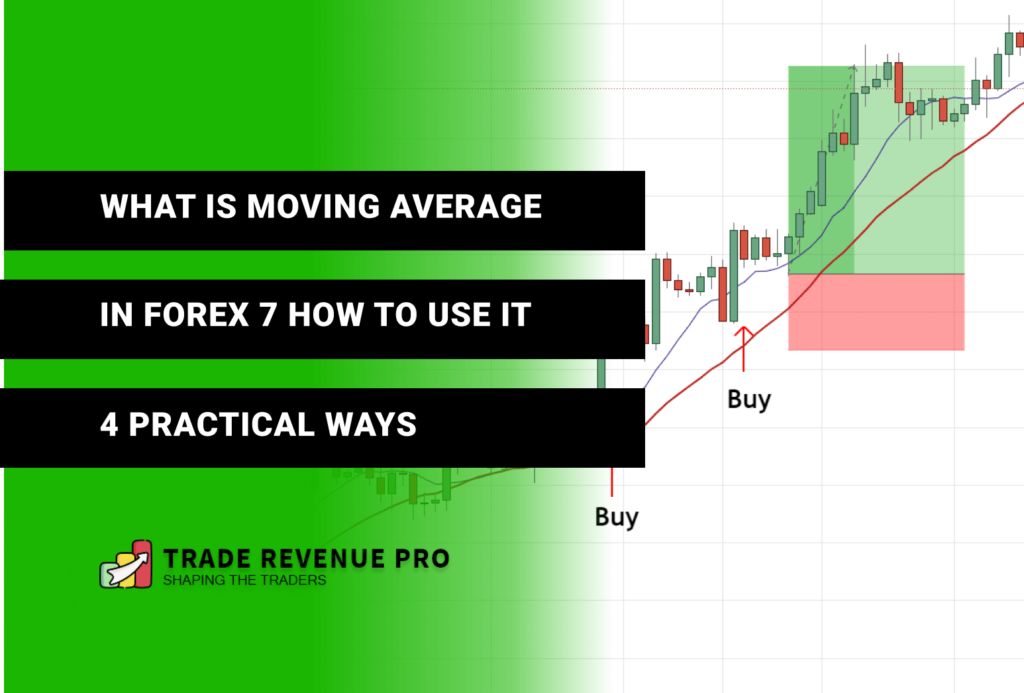Let’s start things off with a quick review of the basics.
Specifically, Today we are going to look at what is moving average in forex and How to use it correctly.
You will also learn how to use a moving average in different market conditions.
Here is what we are going to learn,
- What is the moving average in forex?
- Different Types of Moving Average
- 4 Uses of Moving Average
- How to Trade Forex Market With Moving Average (2 Profitable Trading Techniques)
- Double Moving Average Method for Trend Trading
- Spot Trend Reversal With Moving Average
So Why use moving averages? Because it works.
Need proofs?…
It helped me banked +10% gains in this year so far.
On January 2020 NZDUSD trend reversal trade helped me to bank +5.28%.

And on May 2020 a Trade on EURAUD helped me to bank +6.48%.

So, at the end of this article, you will learn how to place trades like these using a moving average.
But before that…
Let’s learn about the basics.
What is Moving Average in Forex?
Just like the Price actions and RSI, Moving Average is also a popular trading indicator and this indicator has become a core part of any strategy out there.
The ability to identify trending markets and trend reversals makes this indicator a very effective trading tool.
Although moving averages have lots green side, this still a lagging indicator. That is the only downside of this indicator.
But is it actually a downside? If you use moving average alone, yeah this will cause you lots of money.
But if you combine price action or any other trading confluences with the moving average, then at least you have a chance to survive in this ever-changing market.
Next…
The moving averages have two main type
- Simple Moving Average (SMA)
- Exponential Moving Average (EMA)
Both SMA and EMAs are average of a particular amount of data based on a specific time period. The only difference between these two type moving averages is, the exponential moving average (EMA) put more weight on recent price data while the simple moving average (SMA) is not.
Basically, EMA is faster than SMA. Have a look at the forex chart below,

Now, Let’s talk about the basic uses of moving averages.
Uses of Moving Average
Traditionally most traders use the moving average for trend trading. But moving average has many uses. Let’s talk those uses one by one.
The moving average can be used to,
1.Identify Trend Direction (Can use as trend filter)
One of the great benefits of moving average is that it can be used as a trend filter.
When the price is trading above the moving average, it indicates the price is in a general uptrend.
and when the price is below the moving average, it indicates the price is in a general downtrend.
Let’s take 21-period exponential moving average for an example.
Have a look at the chart below where the price is in a general uptrend.

And have a look at the downtrend market where the price is trading below the 21-period moving average.

Next… the moving average in forex can be used to
2. Identify Dynamic Support and Resistance in the Market
Now you know how to identify trending market using moving averages, right?
Next…
Let’s take a look at how to find high probability trade areas to trade along with the trend.
For this, we are going to use 21-Period EMA and 9-Period EMA.
Have a look at the chart below and observe how price respected to the dynamic support zone (dynamic support and resistance zone = Area between 9 and 21 EMAs)

And have a look at the downtrend where the price is going down while respecting the dynamic resistance.

Another way we can use the moving average is to,
3.Identify Trend Reversals.
Just like moving average helps us to identify trending markets, It also becomes very useful when it comes identifying trend reversals early.
Before we even looked for trend reversals, First, we need an established trend to look for a trend reversal, right?
Let’s assume that we have a healthy trend.
Now…
How we are going to decide whether the trend is going to reverse or not by using a moving average.
This is where Break and Retest forex chart pattern come in.
First, we are looking for a break of the moving average. (During an uptrend, we are looking for a break below the moving average and during a downtrend, we are looking for a break above the moving average).
Then we wait for the price actions to pull-back and retest the moving average. This way we can confirm the breakout and avoid false breakouts.
Now, Have a look at the chart below (We are using 21 Period EMA).

According to the above chart, to confirm trend reversal we need a breakout and retest, right?
In this case, we have both.
Have a look at the trigger line (Dashed line on the chart) which is a low point of the breakout trust, right?
After Break and Retest, We can increase our odds if we can wait for a break below the trigger line as well. This is another great way to avoid false breakouts.
This is the last way we can use the moving average in forex trading. That is to,
4. Identify Market Condition.
The Forex Market is always changing, It goes through different market cycles – Uptrends, Downtrend and Sideways.
We can identify those market phrase easily with our eyes. But some times messy price actions makes us confused when identifying those markets phrases and the reason is Forex market is not perfect.
This is why as forex traders we need to follow a systematic approach. This helps us stay consistence.
This brings me to a question.
How do we consistently identify market phrases?
This where the moving average in forex comes in. It helps us to identify different market phrases in a systematic approach.
But how? Have a look at the bullet point below.
- When the Price is below Moving Average – It is a Downtrend.
- When the Price is above Moving Average – It is an Uptrend.
- When the Moving Average is flatten – It is a Range Market or Messy Market that we should avoid.
Now Have a look at the chart below,

There you have it – 4 different uses of moving average.
Now, Let’s talk about how to trade the forex market using a moving average.
How to Trade Forex Market With Moving Average
There are endless possibilities when it comes to moving average.
You have got different moving average periods (50-period moving average, 20-period moving average, etc) and different types of moving averages such as SMA, EMA etc.
But…
Which is the best moving average?
There is no such thing called “Best moving average”. It depends on market conditions.
You can use 50-period moving average to catch longer trend while 21-period exponential moving average helps you to catch quick trends.
So when thinking about a moving average strategy, first you have to decide on what kind of market condition you are going trade or what kind of move you are going catch.
Assume that you aim for quick trend moves, Then 21-period simple moving average is the best choice for you.
Now, Let’s talk about 2 moving average strategies.
- Trade Trends with Double Moving Average Strategy
- Trade Trend Reversals With 21-Period Simple Moving Average
Double Moving Average Strategy
Moving Averages can certainly help to determine the trend direction.
But, Determining the trend directions is only one part of the whole trend trading strategy.
Then…
What else do we need to fill the other part?
A high probability trade location to trade in the direction of the trend.
This location can be found by adding two moving averages to your chart – 10 Period EMA and 21-Period EMA.
These two moving averages help to determine dynamic support during an uptrend.
And,
In a downtrend, these two moving averages work as a dynamic resistance.
We already talked about this, hence we are not going to talk about this in detail.
Let’s take an uptrend as an example to see how to buy from dynamic support.
We are using Price action confirmations as an entry trigger.
Learn about How to Read Candlestick Patterns in Forex – The Definitive Guide
Now have a look at the AUDJPY daily chart below,

What have you noticed in the above chart?
An uptrend, right?
But not only that but the uptrend is respecting to dynamic support as well. (Look at the first bounce).
Now we have to look for a long opportunity, right?
Have a look at the current price. Where it right now?
At the dynamic support. Now it is time to buy. But how?
This is where price action plays its role. Have a look at the bullish engulfing pattern occurred at the dynamic support. This indicates buying pressure.
Now all set. We are looking to buy at the dynamic support utilizing the bullish engulfing pattern. Now it is time to place stops and target.
Have a look at the final result.

Boom…
Withing a few days price shoot up and hit our target.
Now let’s take a downtrend and see how this trading technique works.
Have a look at the EURAUD daily chart below,

This example is the same as the previous one. The only difference is this time we are looking at a downtrend.
What is happening here?
Price moving down while respecting to dynamic resistance.. right?
The occur of the bearish engulfing pattern is significant here. Why?
Because the bearish engulfing pattern occurred at the dynamic resistance which is a higher probability area to go short.
Now it is time place orders and waits.
Have a look at the final result below.

Just like the previous one, price push down and hit the take profit quickly.
This is how you are trading trending markets using the moving average.
Next…
We can also use moving averages to find trend reversals and ride the trend from the beginning.
Let’s talk about how.
How to Trade Trend Reversals – Moving Average Strategy 2
Where you can find trend reversals?
At the end of the trend, right?
Which mean we should have an established trend beforehand we look for a trend reversal. Let’s assume that we have an established trend. Our next job is to identify reversal signs.
How we can identify those reversal signals early by using moving averages?
This where moving average breakout comes in. Keep in mind that the break of the moving is just an early reversal signal, not a trade signal. You cannot buy or sell whenever moving average break above and below.
Let’s assume that moving average breakout as the second indication of a trend reversal.
Then where is the first indication?
We can use chart patterns (Head and Shoulders, Double Tops and Bottoms) as our first trend reversal indication.
Is that all? NO.
After the breakout, we can use retest of the moving average to confirm trend reversal. This way we can avoid a false breakout.
Confused?
Okay, here are the steps,
- First, we need to find an established trend.
- Second, we have wait for reversal chart patterns – Head and Shoulders, Double top, etc.
- Then we wait for a break below the moving average.
- And finally, we are looking for a retest of the moving average.
Let’s take an example,
Have a look at the AUDJPY daily chart below.

According to the above, You can see that the occurrence of the double top pattern is the first trend reversal sign.
Then the price broke below the moving average. This even confirms the trend reversal, right?
After the breakout price starts to retest the moving average. This is where we need to place our orders, right?
Have a look at the final result of this trade.

Woow… Quick profit.
Okay, Let’s talk about one last example before we wrap this article.
Have a look at the CADJPY bearish trend below.

If you look left you can see an established bearish trend which is dominated by the sellers until the price hit weekly support level. This indicates sellers are struggling push price further down.
Next, the price starts to move up break above both local structure level and the moving average. Now we have to wait for the retest of the moving average. We got that too. But this time price pullback and retest both structure level and the moving average. This is a good sign.
Now it is a matter of placing the orders, right? Let’s do that.
Have look at the chart below,

It took some times but at the end price hit our take profit, right?
As you already saw we used simple trading techniques along with the moving average to place trades.
Now here is the Bonus Tip.
You already know how to place trades using a moving average. But if go through historical data, the trading techniques we talked here is not always profitable. Just like any other strategies, These strategies also suffering from loses.
But what if there is a where to increase the win rate? that is great, right?
Okay… this can be done easily by taking only quality trades. But how?
Here is the formula,
- First find higher probability trade location and trade only around these locations (Support and Resistance, Round Numbers and Fibonacci Level).
- Second wait for an RSI divergence. Because RSI divergence indicates the weaknesses of the trend by analysing price momentum.
- Third Use Moving average and chart pattern to enter a trade.
Have a look at the trade below,

According to the chart above,
First, we have a head and shoulders pattern. This indicates the weaknesses of buyers. Then RSI divergence even confirms the idea of head and shoulder pattern.
Read More About RSI Divergence – How to Trade RSI Divergence – 4 Practical Trade Entry Techniques.
After that price break below and retest the moving average. This signals us to reversal is ready to take off.
But there is a problem. What if price bounced up from the structure level. We will get stopped out, right?
An easy way to avoid this is to wait for a break below the local structure level.
That is what we exactly did. Have a look at the chart above.
Just like that make a trading habit of combine trading confluence and trade only around higher probability area when trading with moving average in forex.
Talking of trading habits here is the 20 Forex Trading Habits To Level up Trading Career.
Now it is your turn,
Go through few forex chart and try to apply trading techniques we talked here so far.
If you feel like these trading techniques are for you. Implement these techniques to your trading plan.
I Hope got valuable information trading techniques from this article. If you think this article is a good one, Help us grow by sharing this on social media.
Also, consider following us on social media – Facebook and Instagram.







